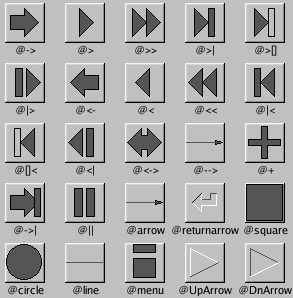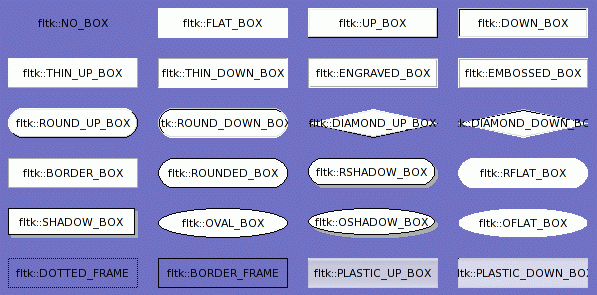Symbols, Box types, and @-commands
FLTK defines a whole lot of static instances of subclasses of Symbol. Most of these are designed to be invoked by their name by imbedding @-commands into drawtext() calls. There is also a set of box types with pointers declared to them so you can set the boxes of Style and Widget objects.
Layout commands
Note that all @-commands must be terminated by either a ";" semicolon, by the start of another @-command, or by whitespace (which is not consumed).
"&x" underscores the 'x'. This is a standard from Microsoft.
"&&" prints a single "&".
"@@" prints a single "@" sign. This is not a symbol, the next character is printed or interpreted even if it is a semicolon or space.
"@;" truncates the string at this point. This can be used to hide program internal data in the label() by putting this before it.
"@n" in a label resets the font, color, and positioning offset to the settings they were when the label started.
"@b" in a label changes the font to bold.
"@i" in a label changes the font to italic.
"@f" or "@t" in a label changes the font to fixed-pitch.
"@Ccolor" will change the color of the text. Color can be any string accepted by parsecolor().
"@sN" will set the font to N/12 times the current size;
"@sNp" will set the font to N pixels.
"@s+N" will multiply the font size by (12+N)/12
"@s-N" will multiply the font size by 12/(12+N)
"@s+Np" will add N pixels to the font size
"@s-Np" will reduce the font size, but the amount is subject to change.
"@s0" will restore the initial font size.
"@S..." is the same as "@s..." for back-compatibility.
"@." prints nothing and also stops any interpretation of @ or & characters later in the string. This will allow you to concatenate some @-commands to the start of an arbitrary string.
"@x+N" draws a blank exactly n*(fontsize/12) wide.
"@x-N" moves backwards by n*(fontsize/12) (ie it kerns).
Add a 'p' suffix to the number to move exactly n pixels, instead of a scaled amount. Other suffixes may be added in the future.
"@y+number" will move the y origin up by n*(fontsize/12). "@y-number" will move the y origin down n*(fontsize/12). This can be used to produce super/subscripts. Add a 'p' suffix to the number to move exactly n pixels, instead of a scaled amount. Other suffixes may be added in the future. To restore the y origin to the baseline, use the "@n" command.
"@Bcolor" draws a solid box of the given color behind the text. "color" can be any string understood by parsecolor(). Not sure if this is compatible with fltk1.1.
"@l" makes the rest of the label be left-justified. Note that this is incompatible with fltk1, which used this to set the size to 24 points.
"@c" makes the rest of the label be centered.
"@r" makes the rest of the label be right-justified.
Symbols

By default these all draw in a square that is the current font size on each side. You can put extra text between the @-sign and the name to get some additional effects:
- "+digit" will enlarge the square by 1/12 of a point size, "-digit" will shrink it. For instance "@+2square;" will make a larger than default square.
- Any digits after that are taken as an angle to rotate. A single digit is a "keypad rotation" where the x axis points at the given number on a keypad, for instance '9' it 45 degrees up, and '4' is upside-down. '5' and '6' cause no rotation. For instance "@4>" will make a triangle pointing left. "@+14>" is a bigger triangle pointing left.
- Multiple digits are a rotation in degrees. To do a rotation less than 10 degrees use a leading zero. For instance "@25->" is an arrow pointing 25 degrees up. "@-125->" is a slightly smaller arrow pointing 25 degrees up.
Box types

These are all referenced by pointers defined in Style.h.
